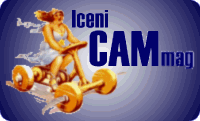Norman of Ashford in Kent, presented its new Nippy moped on stand number 124 at the Earls Court Motorcycle Show in November 1955. It had a rigid frame with leading-link forks, 1.25ps (ps ≅ bhp) German Sachs engine, Sachs hubs, a Hella headlamp, and Magura controls … doesn’t sound very British made does it?

Achilles Capri leaflet
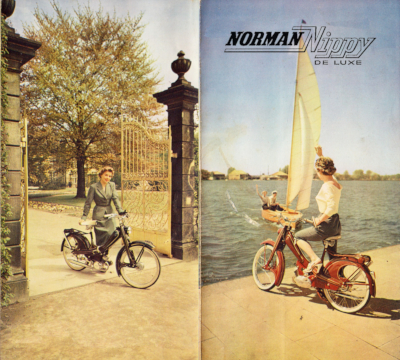
Norman Nippy leaflet
It wasn’t … the bike was factored in from Achilles Werke in Germany where it was sold as the Achilles Capri. Norman even had the cheek to use the original German promotional colour pictures for its own early promotional literature!
Norman followed the popular adoption of the first Nippy moped with the presentation of a Mk 2 model based on the Achilles Capri plunger frame version at Earls Court in November 1956. In January 1957 the Nippy Mk 1 (£69–19s–6d) was succeeded by a new Nippy Mk 2 ‘Springer’ model (£71–19s–6d), now with plunger rear suspension, otherwise still the same machine from Achilles and, by this time, the Sachs motor had progressed up to a 1.6ps rating.
Autocycle sales by all manufacturers had slipped into a steady decline in the early ’50s, with Bown and James discontinuing their autocycles during 1954, leaving just Norman and New Hudson as the last 2F customers. Norman built out its remaining 2F engines and discontinued its Model C autocycle in 1957, leaving the Nippy Mk 2 ‘Springer’ to take over its place.
Increasing affluence across Europe was however creating increasing demand for motorcars, while interest in bikes decreased, with the resultant closure of numerous two-wheel manufacturers. This fall in business caught up with Achilles’ earlier capital investments before the costs had become amortised and, during 1957, the Achilles company filed for bankruptcy; it looked as if the Norman Nippy moped might be coming to the end of its road.
As part of the British Cycle Corporation since 1953, and backed by the finance of Tube Investments Group, Norman sought to purchase the tooling and rights from Achilles’ receivers to continue moped manufacture for itself.
Back in Germany, the yard gates of Achilles Werke at Langewerth were locked shut for the last time in 1958. We don’t know at what point Norman secured purchase and shipment of Achilles moped tooling, but now the race would be on to get production underway before stocks of the Achilles-assembled ‘Springer’ Capri Mk 2 ran out.
Villiers notified the 2F Autocycle engine as being discontinued in 1958, which would end New Hudson’s production of its re-styled model as it used up the last engines.
Half-a-Crown each way

Loading Norman mopeds on to
a Silver City Bristol Type 170 Freighter
Following Villiers’s introduction of the 3K moped engine in summer 1958, Norman immediately began reworking its models to incorporate this motor and unveiling a new Lido 3K model in a staged press release at Lydd, Kent, accompanied by a plunger frame Nippy Mark 2 ‘Springer’ with its Sachs engine. This early publicity appeared in Motor Cycling on 9 October 1958 and seemed to be by mutual arrangement with the airline promoting a new 2s–6d fare for an under-100cc crossing to the continent by Silver City Super-freighter from Ferryfield (now called London Ashford) airport.
Clearly timed for press release at the Earls Court Motorcycle Show on Norman stand No.33 in November 1958, Norman announced its new Norman Lido with Villiers 3K motor, and notified cessation of the Nippy Mk 2 ‘Springer’ model, which had been priced at £74–9s. Then somewhat strangely, the Sachs engined ‘Springer’ seemed to be re-listed again as ‘special order only’, and was joined by another cheaper Villiers 3K powered ‘Springer’ moped priced at £65–2s.
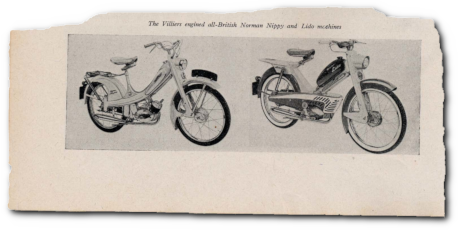
Norman mopeds in Power & Pedal
Pictures of the two Villiers/Norman mopeds in the Show edition of Power and Pedal showed the new Norman Lido and an Achilles Capri ‘Springer’ moped now seemingly fitted with a Villiers 3K engine and clearly illustrated with all the same German cycle parts that Achilles had fitted.
Following the Earls Court Show the main focus of promotions and road tests was obviously the new top moped model Norman Lido, but as the months rolled on, there seemed nothing further appearing about the new Nippy Mk 2 ‘Springer’ with its Villiers 3K engine. It didn’t seem as if Norman ever released any official pictures of the machine [See the addendum], no illustrated pictures in advertising, and we’re not even able to find any trade road tests published on it throughout the whole of 1959!
It’s almost as if the bike never officially existed … but the ‘Springer’ had returned, and Norman would be selling them, lots of them, throughout 1959. What actually went into production was also markedly different from the November 1958 picture in Power and Pedal.
We’ve even got one to test, and this is what it really looked like…

No longer made in Germany, the new ‘Springer’ moped was built by Norman at Ashford in Kent, and though it was still based on the same Achilles Capri plunger frame, pretty much everything else had changed. The new Nippy Mk 2 type 2 had Lido forks to replace the Capri fork, British Hub Co hubs instead of Sachs, Dunlop Endrick pattern rims, Lido mudguards, Villiers 3K engine and exhaust, Miller headlamp and horn in the plastic Lido nacelle, Miller rear lamp and switchgear, a heavy gauge and crudely formed pressed steel chain guard, a simple tubular rear carrier, and Amal controls on the Lido handlebar console.
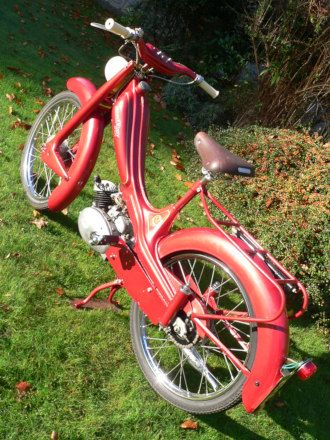
So what were the changes to the cycle parts about?
This was probably an exercise to reduce component complexity by switching to parts common to the newer Lido model, and replacing continental proprietary accessories with British domestic market equivalents. The parts being superseded were the earlier Capri components, which saved Norman from having to press a duplicate fork set, mudguards, headlamp nacelle, the earlier continental press-formed chain guard (which was replaced by a simple bent steel plate), a basic rear carrier without the parcel clip, and the toolbox deleted.
The difference between Made in Germany and Made in England saved £9–7s (12.5%) on equivalent models of the Mk 2 ‘Springer’.
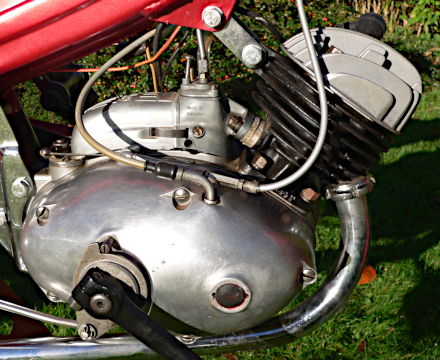
The Villiers 3K engine with cast iron cylinder was specified at 40mm bore × 39.7mm stroke, with 7:1 compression ratio alloy head for a rating of 2bhp @ 5,500rpm, and fed by Villiers’s own SM10 carburettor with a 12mm venturi. However the engine on our feature machine has been rebored to +0.040” (1mm) oversize, so now increasing the swept volume to 52.4cc, which also increases the compression ratio to 7.5:1, so it may go a little better than standard.
Fuel tap is at the bottom-left of the in-frame tank, and so close to the carb that the Ewarts off–pull on–turn and pull for reserve tap has an unusual 90° outlet spigot on the side. Was this a special fuel tap made judy for this model?
While we have previously found the flood button to be effective for cold starting on Villiers 3K motors, we thought we’d try out the choke for a change. Just push the choke shutter button down on top of the carb, one spin of the pedals and it fires up first time. Open the throttle and the choke shutter lifts off, which actually works well, and doesn’t leave a flood puddle under the bike.
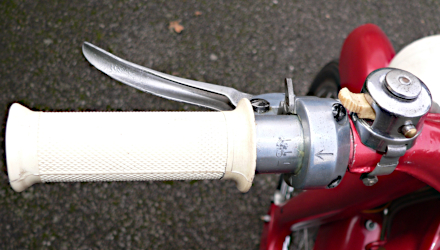
Pull in the clutch lever, twist the grip down & forward for first, and hold it down as you release the lever to locate the gear. The engine pulls away easily and responds well to the throttle; then clutch in and twist the grip up & back for second. The engine torque is still impressively strong enough to pull from low revs, and you really can feel some difference from the small changes to the motor.
We find what feels to be a happy cruising speed, but have no idea what speed that actually is because our Nippy only has an original blanking plate with no speedo—fortunately we have our pacer, who subsequently reports this at 28–30mph.
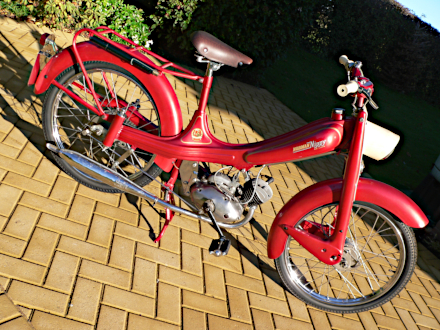
Best on flat clocked 33–34mph, and best speed downhill clocks 35, at which it honestly still felt to be over-revving despite being geared up 8.3% from the standard 12-tooth front sprocket, to 13 teeth. This suggests it could probably still manage pulling a higher (14-tooth) ratio, though may then fall back against hills in top, so would need to be suitably balanced in terms of capability according to the local terrain. The 3K engine will climb any gradient in first, so maybe just restraint with the throttle is required to avoid over-revving in top gear on downhill sections.
Vibration felt through the saddle warranted comment: it’s ‘disturbing’!
The front brake was effective, the back-pedal rear brake was very effective. General handling was good, though the suspension proved somewhat harsh on bumpy road surfaces—but that’s how it was in 1959.
All the lights worked well, and the horn quacked like a duck.

While Glass’s Index was already indicating Norman Villiers 3K engined Lido and Springer models for sale from November 1958, they probably wouldn’t have actually become available in agents’ shops for at least three months, but Norman would certainly have had them on the high street for the start of the 1959 sales season. Phillips however, was in no position to present its own 3K-engined Gadabout so quickly, since it still had contractual obligations and stock of the two-speed Rex engines, so the P45 couldn’t really be introduced as a replacement until its two-speed Rex motors had been used up, when the P39 Gadabout was subsequently notified as de-listed in July 1959.
Maybe Norman was unconcerned with promoting the Mk 2 type 2 as a new model, and just continued to refer to it as a ‘Springer’ now fitted with the Villiers engine, because it was only really intended as a one-year stop-gap machine until it got the new Mk 3 & Mk 4 Nippys into production with the planned in-frame fuel tank version of the Lido frame.
How many?
Norman moped frame numbers can generally be related to respective models, with an NV prefix applied to Sachs-engined models up to 10,000 when the prefix was dropped.
A-prefix: Norman Lido with Villiers 3K engine.
B-prefix followed by 5-digits: Nippy ‘Springer’ Mk 2 type 2 with Villiers 3K engine.
E-prefix: Nippy Mk 3 and Mk 4.
The Nippy Mk 5 and Lido Mk 3 used Raleigh-style frame numbers.
It looks as if the Nippy Mk 2 type 2 frame sequence probably started at B01000, and continued to around B09000, suggesting up to 8,000 having been built and sold in less than one year.
The Norman Lido 3K was priced nearly £10 higher, resulting in appreciably fewer sales than the much more popular ‘Springer’ 3K’.
When Norman shipped the Lido press tooling from Germany, sometime in 1958, the two frame tools (or a single 1+1 tool, though that’s unlikely due to the press size required) would only produce the Lido frame (without fuel tank). Major engineering works would have been required to either make a complete second tooling set, or modifying to convertible inserts to produce both the new in-frame fuel tank (Nippy), and spine-frame Lido from existing tooling. This tool engineering would have been a big job and would have taken some time to execute, so Norman produced the interim Mk 2 type 2 model from the old Capri frame tooling since they could put that straight into a press and go with it to ‘mind the gap’.
They might also have needed to pre-run the required number of pressings from the Lido frame tooling to meet the forward production plan for 1959 until the revised tooling came back from conversion.
By October 1959, the company notified discontinuance of both the 3K Lido and Nippy Mk 2 type 2 models in preparation for the announcement of a complete new range of mopeds in November at the Earls Court Motorcycle Show.
By early December 1959 adverts were already appearing in the motor cycling press promoting new Nippy Mk 3 (MiVal), Mk 4 (Villiers 3K), and Super Lido (Sachs) models for sale in the forthcoming 1960 season.
This wasn’t the end of the Achilles Capri / Norman Nippy Mk2 ‘Springer’ frame however, as it went on to a further evolution…
At the end of Norman production in 1959, all the Capri tooling was sold, by way of Raleigh (South Africa), to Israel Cycling Manufacture, where it returned to production fitted with a Sachs engine, and sold again as the ICM Tilon moped in Israel from 1960.
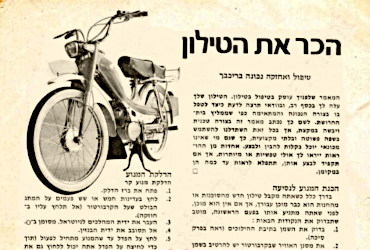
A swing-arm Norman Nippy: the ICM Tilon
Some 300 were built in 1960, 700 made in 1961, a further 700 in 1962, 1,750 in 1963, 950 in 1964, and 650 in 1965.
The leading-link front fork became converted to a telescopic fork set after the mid-1960s, then the frame later adapted to a swing-arm rear suspension arrangement.
1971 was another peak year with 1,625 Tilon mopeds sold, after which the numbers steadily trickled down until the last year of just 100 in 1979.
